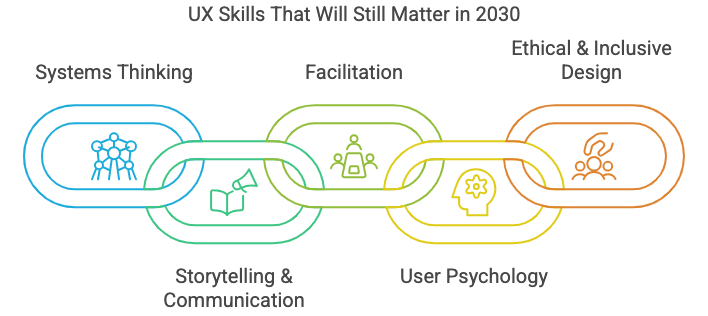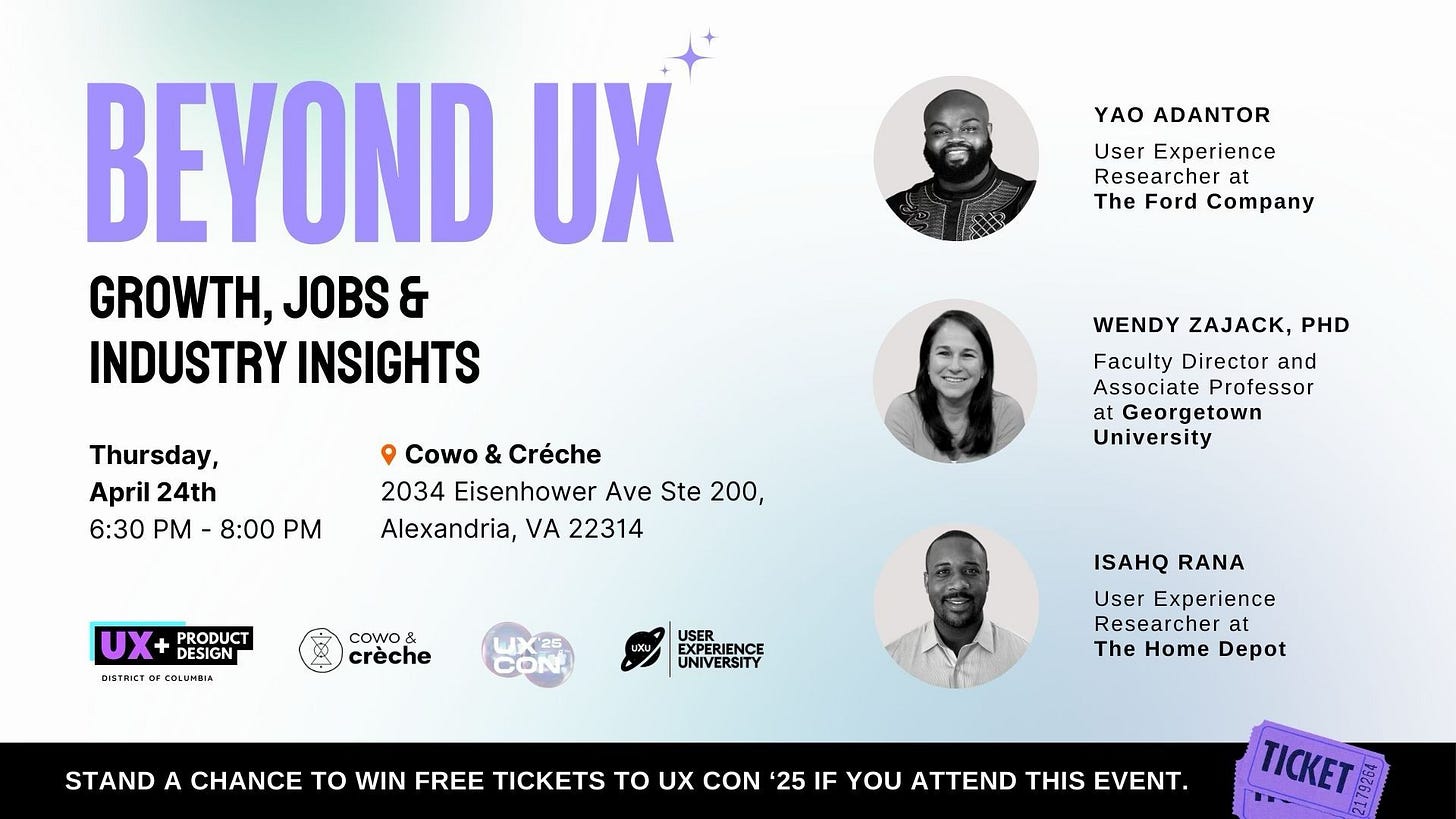Future-proofing your UX career
UX Skills That Will Still Matter in 2030
Let’s talk about the question that’s keeping a lot of UXers up at night:
“Is AI going to replace my job?”
Tools like ChatGPT, Galileo, and Uizard are designing interfaces in seconds.
Personas? Auto-generated. Wireframes? Done.
Design systems? Built into code.
It’s easy to feel like you’re falling behind.
But here’s what’s true: UX isn’t going away. It’s evolving.
And while some tasks are becoming automated, the core of UX—the human part—still needs you.
In this issue, we’re breaking down the UX skills that will still matter in 2030—skills you can start deepening today to make yourself indispensable tomorrow.
📌 What’s Inside
The 5 UX skills no AI tool can replicate
Why these skills are gaining value—not losing it
How to start developing them now (without going back to school)
Free Conference: Beyond UX: Growth, Jobs & Industry Insights (Win a FREE ticket to UXCON '25)
Resource Corner: Books & guides to sharpen your edge
🧠 The 5 UX Skills That Will Still Matter in 2030
1. Systems Thinking
Tools can solve micro problems. But you see the full ecosystem.
How a decision in onboarding affects retention. How an interaction influences trust.
As products become more interconnected, designers who understand the bigger picture will be in demand.
“Systems thinking is a critical skill for designers to understand the broader context of their work and anticipate the ripple effects of their design decisions.”
Source: DesignersForest
2. Storytelling & Communication
You’ll still need to tell the story—of the user, of the data, of the design.
AI can generate slides. But it can’t rally a team behind a shared vision or convince a skeptical stakeholder why this design matters.
Great storytelling = better buy-in, faster decisions, stronger influence.
3. Facilitation
Workshops, alignment sessions, research debriefs—these are where product decisions happen.
In an AI-rich future, facilitators who can guide messy human conversations into focused outcomes will be the difference between teams that ship smartly and those that spin.
4. User Psychology
Understanding what motivates people, where friction comes from, and how trust is earned?
That doesn’t come from templates.
Deep UX insight comes from years of paying attention—and asking the right questions.
It’s also how you spot where AI outputs fall flat: "That journey map looks good, but it doesn’t feel like our user.”
5. Ethical & Inclusive Design Judgment
AI doesn’t have a conscience. You do.
UXers who understand equity, accessibility, and the unintended consequences of design will be the moral compass teams lean on.
Your ability to ask “Should we?” instead of just “Can we?” will matter more than ever.
⚙️ Why These Skills Are Gaining Value—Not Losing It
As automation eats the repeatable tasks (wireframes, UI variations, documentation), what remains—and rises in value—is human sense-making.
No tool can replace:
Your judgment when a flow doesn’t feel right
Your ability to advocate for a real user scenario that doesn’t match the data
Your instincts when a feature might technically work but ethically fail
In a world of high-speed output, clarity, empathy, and strategic thought are the premium layer.
📈 How to Start Building These Skills Today
Run your next critique with a “systems lens.” Ask: “What ripple effects does this design have on the rest of the experience?”
Practice storytelling. Share a UX win on LinkedIn—not just the result, but the journey.
Facilitate a mini workshop with your team, even if it’s informal. Use Miro or FigJam to lead a conversation.
Reread a usability test transcript. Annotate it for emotion, not just task flow.
Ask “who might this leave out?” in your next design decision. Include that voice.
The best part? These aren’t skills you need a bootcamp to develop. You just need awareness, repetition, and feedback.
🎙️ [In-Person Meet-up]: Join Us for an Evening of Growth, Jobs & Industry Insights
UX is shifting, and so are career opportunities.
Whether you’re a seasoned pro, transitioning careers, or a student breaking into the field, this event gives you insider knowledge on hiring trends, career growth, and the future of UX.
Join us at the UXCON Spring Meetup with UXPD (UX + Product Design, DC) on April 24th for an insightful in-person discussion about UX careers, industry shifts, and what’s next for the field.
Attend and stand a chance to win a FREE ticket to UXCON '25!!!
📚 Resource Corner
🎯 Designing with Intent: Calvin Robertson on Balancing Digital and Human Interactions
As UX continues to grow, understanding how to seamlessly integrate digital solutions with human touchpoints is crucial. Calvin Robertson, Founder of Obcidion Inc. and Jubileague, delves into this topic in a compelling podcast episode.
🧠 Key Insights from Calvin:
“Design is most powerful when it enables choice, not just efficiency.”
Calvin explains how true UX impact comes from empowering users—not streamlining them into narrow funnels.Human-centered ≠ convenience.
Designers often confuse ease with care. But Calvin reminds us that good UX doesn’t just make things faster—it makes them feel intentional and respectful.“Your best work comes when you stop trying to ‘own’ the user and start understanding them.”
Calvin challenges teams to drop the control mindset and instead design from a place of empathy and systems thinking.
🚨 Want more of this thinking in real life?
Calvin Robertson is bringing this same energy and insight to UXCon25. If you’re ready to expand how you think about UX—from screens to systems—this is a session you won’t want to miss.
Final Thought: Tools Will Change. Your Thinking Is the Asset.
Every time new tech comes along, the question comes up:
“Will this replace me?”
But the UXers who stay relevant don’t obsess over tools. They double down on the thinking that makes good design possible.
You are not your wireframes. You are not your job title.
You are your ability to solve real human problems—with empathy, logic, and care.
And that will always matter.



